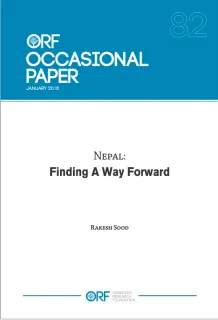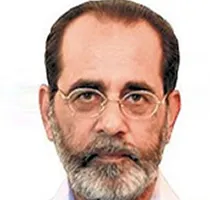Nepal promulgated its new Constitution in September 2015. Rather than being a cause for universal celebration, however, the event has only led to increased polarisation within the country. The Terai region, for instance, which has been in the throes of an agitation since mid-August of 2015, has witnessed the different parties hardening their position and showing little sign of nearing compromise.
Nepal’s relations with India have also been on a downward spiral. Nepal’s economy, already battered by the massive earthquake in April 2015 is suffering more as supplies of essential goods from India have slowed to a trickle. India blames the insecurity caused by the Terai agitation for this disruption, even as it urges the Nepali government to find a compromise. Meanwhile, the popular perception in Nepal is that such disruption in supplies is the result of an informal Indian blockade. For the first time in the history of their bilateral relations, India and Nepal exchanged serious allegations against one another before a recent UN Human Rights Council session in Geneva. There has thus been a marked shift in Nepal-India relations, falling from the high of August 2014 when the view was that Prime Minister Narendra Modi’s visit at that time had won the hearts and minds of Nepali society and a new chapter in India-Nepal relations had begun.
The paper opens by describing some of the most significant political changes in Nepal which provided the context in the drafting of the new Constitution. It then discusses the ebbs and flows in India-Nepal relations, and the intertwining of Nepali nationalism with anti-Indianism. The paper then examines more recent developments in Nepal’s internal affairs and its spiralling relations with India. The closing section identifies the reasons behind the impasse and the efforts that need to be made by all stakeholders for Nepal to get over the current crises, and for its bilateral relations with India to improve.
Nepal is no stranger to Constitution drafting, the last one being the seventh such exercise since 1948. e 2015 draft, however, was fundamentally
dierent as it was conducted, for the rst time, without the oversight and guidance of the monarchy. Certain populations of Nepali society had specic stakes in the 2015 Constitution drafting. For many of Nepal's marginalised communities such as the Madhesis, for example, the new Constitution was a time of hope that their six-decade-old struggle for equality and inclusiveness will nally come to a closure.
Nepal has had a challenging history of writing its Constitution. e 1948 Constitution was stillborn: proclaimed by then Prime Minister Padma Shamsher Rana, it had not been implemented fully before he was overthrown by his cousin, Mohun Shamsher Rana. Following the end of the Rana regime, an Interim Constitution was introduced in 1951, as a rst step towards normalising the country's electoral politics. King Mahendra replaced this with a new Constitution in 1959, which gave the monarchy enhanced powers and which the King used to dismiss the elected government. In 1962, King Mahendra promulgated yet another Constitution which introduced the party-less Panchayati Raj, a system in which the heavy hand of the Palace was always close by. e Jan Aandolan in 1989 led to the promulgation of a 1990 Constitution which retained the monarchy but with signicantly reduced powers and introduced multiparty electoral democracy. Following the ten-year-long Maoist insurgency from 1996 to 2006, an Interim Constitution was introduced in 2007, to pave the way for the Constituent Assembly elections in 2008, which in turn led to the 2015 Constitution.
The 2008 elections altered the political landscape of Nepal, with the Maoists and the Madhesis emerging as the country's new political forces. While the Madhesis had been agitating for their rights since the 1960s, the Maoist insurgency had given birth to an identity-based political demand for federalism for which the two main political parties, Nepali Congress and the UML, had never shown enthusiasm. e smaller pro-monarchy parties had opposed federalism on the grounds that it would lead to fragmentation. In addition to the demand for abolishing the institution of monarchy, the Maoist demand for federalism was partly driven by ideology and also by the fact that the Janjatis constituted a signicant support base.
Broadly speaking, Nepal has been ruled by the Khas Arya (Bahun Chetripahadi elite) who constitute about 30 percent of the country's population. Belonging to the Shah, Rana and akuri communities, they mostly trace their descent from India's Rajput families. e Janjatis (indigenous hill tribes) make up another 30 percent of the population and consist of Magars and Gurungs (primarily between Gandak and Karnali river basins) and Rais, Limbus and Tamangs, concentrated in eastern Nepal. Madhesis (including Dalits and Muslims) and arus (indigenous plains tribes) are based in the Terai and account for another 35 percent of the population. Among the Terai-based groups, the Madhesis have close ties with the Indian population in the northern districts of Bihar and Uttar Pradesh, often evocatively described as roti-beti-ka-rishta, which has led the ruling elite to question their allegiance during periods of domestic political polarisation. Incidentally, it is not only the Madhesis but the Khas Arya, too, have strong ties with their counterpart Indian aristocratic and landowning classes, though this does not attract similar questioning. Traditionally, the Janjatis, arus and the Madhesis have been the marginalised communities of Nepal. Up until 1958, the Madhesis needed a special permit to enter Kathmandu Valley.
Given the concentration of the Madhesis in the Terai and the open border, King Mahendra undertook a major administrative restructuring during the Panchayat era with the objective of diluting their majority. e number of districts in Nepal was increased from 32 to 75. In the process, the Terai-based districts which were earlier geographically restricted to the plains, were recongured to include areas north of the Siwalik Hills. With the construction of the East-West Highway, new Pahadi settlements were encouraged in the Terai-based districts, thereby changing the demographics. e Pahadi population in the Terai went up from six percent in 1952 to 36 percent in 2001. Today, out of the 20 Terai districts bordering India, the Madhesis constitute a majority in less than half. While this change can no longer be undone, it has remained an issue of concern and nds reection in current Madhesi demands relating to federalism.
According to the 2007 interim Constitution, the Constituent Assembly was expected to complete its task in two years, or by 28 May 2010. is deadline was not observed and the task remained unnished even after the CA had awarded itself four extensions, taking it to May 2012. e Supreme Court intervened, putting an end to the exercise of repeated extensions and in November 2013, a second CA was elected for a four-year term. Sensing the public's impatience, it set itself a deadline of January 2015 for completing the Constitution drafting exercise but once again failed. e devastating earthquake in April 2015, which claimed 9,000 lives and caused economic losses estimated at $ 7 billion, showed the political leadership in poor light, pushing them to work for an early conclusion of the Constitution drafting exercise.
The composition of the second CA was dierent from the rst. In 2008, Maoists had emerged as the single largest party with 229 seats while the three Madhesi parties together accounted for only 84 seats. In 2013, Maoists were down to 80 seats and the Madhesi parties, which had splintered from three into a dozen, could manage only 40 seats. On the other hand, the two older parties, NC moved up from 115 in 2008 to 196 and the UML from 108 to 175 seats, together accounting for nearly two-thirds of the CA (whose strength was 601) in 2013. e Maoists lost because of widespread allegations of corruption, poor governance record and inghting. e Madhesis, for their part, failed because of ego clashes, caste dierences between the Brahmins, akurs, Yadavs and Kurmis, and political fracturing which weakened the Madhes movement of 2007 and 2008.
Read the full report here.

 PDF Download
PDF Download



 PREV
PREV


